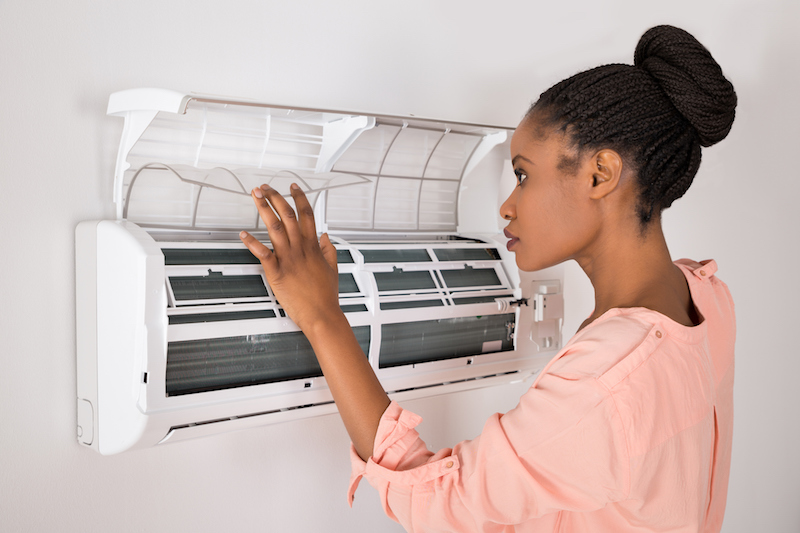
You shouldn’t have to compromise on comfort or spend a lot to keep your residence at a refreshing temperature during warm days.
But what is the right temperature, exactly? We go over suggestions from energy professionals so you can find the best temperature for your loved ones.
Here’s what we advise for the most energy-efficient setting for air conditioning in Myrtle Beach.
Recommended Thermostat Settings for Summer
Most families find placing the thermostat at 72-73 degrees provides ideal comfort. However, if there’s a huge difference between your indoor and outside warmth, your electricity costs will be greater.
These are our suggestions based on the U.S. Department of Energy (DOE) and ENERGY STAR®.
While at home: 78 degrees. While that appears hot, there are methods you can keep your house refreshing without having the air conditioning on constantly.
Keeping windows and curtains down during the day keeps cold air where it should be—inside. Some window coverings, such as honeycomb shades or plantation shutters, are created to offer added insulation and better energy efficiency.
If you have ceiling fans in your residence, the DOE says you can raise thermostat settings about 4 degrees hotter without giving up comfort. That’s because they cool by a windchill effect. As they cool people, not areas, shut them off when you move from a room.
If 78 degrees still feels too warm at first glance, try doing an experiment for about a week. Start by upping your setting to 78 degrees while you’re home. Then, gradually lower it while using the ideas above. You might be astonished at how cool you feel at a warmer temperature setting.
While away: 88 degrees. There’s no need to keep the air conditioning working all day while your residence is unoccupied. Turning the temp 7–10 degrees warmer can save you an estimated 5–15% on your electricity bills, according to the DOE.
When you come home, don’t be tempted to switch your thermostat below 78 to cool your residence more rapidly. This isn’t useful and usually leads to a higher cooling bill.
A programmable thermostat is a good way to keep your settings controlled, but you need to set programs. If you don’t set programs, you risk forgetting to increase the set temperature when you take off.
If you want a handy resolution, consider installing a smart thermostat. This thermostat links with your phone, so it is aware when you’re at home and when you’re gone. Then it intuitively adjusts temperature settings for maximum savings. How much exactly? An estimated $180 yearly on heating and cooling, according to ENERGY STAR.
Another benefit of using a smart thermostat? You can use your phone to keep an eye on and adjust temperature settings from almost anywhere.
While sleeping: Around 70 degrees. While ENERGY STAR recommends 82 degrees, that could be unbearable for the majority of families. Most people sleep better when their sleeping space is cold, so that’s why the National Sleep Foundation suggests 60–67 degrees. But that could be too cool, based on your PJ and blanket preference.
We suggest trying a similar test over a week, moving your temp higher and slowly turning it down to pick the right temperature for your residence. On cool nights, you might learn keeping windows open at night and running a ceiling fan is a better solution than using the air conditioner.
More Methods to Save Energy During Warm Weather
There are additional approaches you can spend less money on energy bills throughout the summer.
- Buy an energy-efficient AC system. Central air conditioners only are effective for about 12–15 years and get less efficient as they age. A new air conditioner can keep your residence more comfortable while keeping energy expenses small.
- Book regular air conditioner tune-ups. Regular air conditioner maintenance keeps your system working like it should and may help it operate more efficiently. It may also help extend its life span, since it allows technicians to pinpoint small issues before they lead to a major meltdown.
- Put in new air filters regularly. Read manufacturer instructions for replacing your air filter. A dirty filter can lead to your system short cycling, or turn on and off too much, and raise your electricity.
- Inspect attic insulation levels. Nearly 90% of homes in the U.S. don’t have proper insulation, according to the Insulation Institute. The majority of southern climates should have 13–14” of attic insulation, while northern climates require 16–18”.
- Have your ductwork inspected. Ductwork that has separated over time can leak cold air into your attic, walls or crawl space. This can create big comfort issues in your house, like hot and cold spots.
- Seal openings, doors and windows. Keep hot air in its place by sealing holes. You can also caulk or weather strip doors to trap more conditioned air inside.
Save More Energy During Warm Weather with Polar Air & Mechanical
If you are looking to conserve more energy this summer, our Polar Air & Mechanical specialists can provide assistance. Reach us at 843-484-3783 or contact us online for additional info about our energy-saving cooling solutions.


